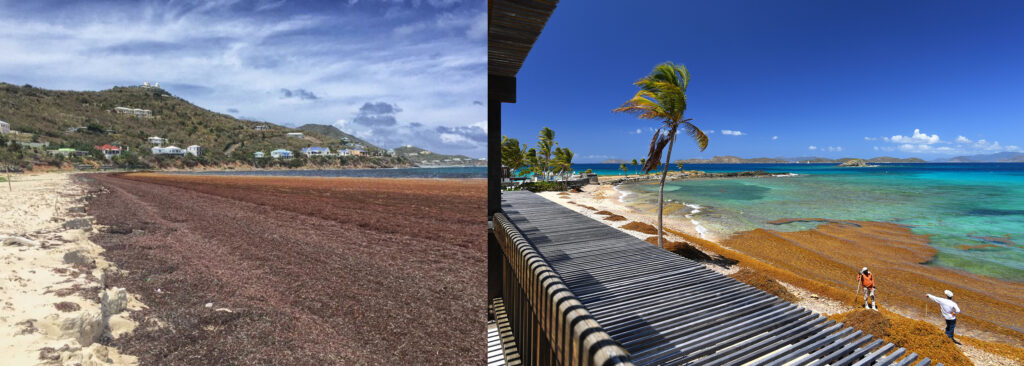SAN JUAN — Slimy, stinky brown seaweed that ruins beachgoers’ vacations from the Caribbean to Florida may be the new normal unless Brazil halts Amazon deforestation, experts say.
The culprit, called sargassum, turns clear-blue sea water a murky brown and smells like rotten eggs when it washes ashore and starts to rot.
The seaweed is a natural occurrence on beaches in the U.S. Virgin Islands, Puerto Rico and elsewhere. It’s part of an ecosystem for fish, crabs and birds.
But it has proliferated dramatically in recent years, covering shores with thick layers of the weed and forcing tourism officials to clean it up so visitors keep coming.
It is an icky nuisance for tourists and an economic and environmental disaster.
“We came from over there, looking for a spot that is cleaner. But it is this way everywhere,” said Maria Guadalupe Vazquez, 70, pointing off into the horizon as she lounges in a beach chair in Miami Beach.
Authorities brought in trucks and front-loaders this week to scoop the stuff up and haul it away. They know this is no long-term solution, however.
One problem is global warming—the hotter the ocean, the more these weeds reproduce, said Steve Leatherman, an environmental expert at Florida International University.
But the bigger problem is the Amazon river, he added.
Scientists say that starting around 2011, much more land along that mighty waterway was cleared for farming.
But it yields a poor, muddy red soil so farmers use a lot of fertilizer, which rains wash into the river, where it flows into the Atlantic. And the fertilizer ends up fertilizing the sargassum.
“Now there’s 20, or 30, 50 times more, 100 times more than we’ve ever had before,” said Leatherman.
“We think this is going to be the new normal so we are going to have to find a way to deal with this, and it’s going to be difficult,” said Leatherman, aka Dr. Beach, as he drove by piles of sargassum on Miami Beach.
‘Environmental disaster’
The stuff is nothing new. When Christopher Columbus saw a bloom of sargassum to the east of the Bahamas, it was so thick he thought it was an island.
That was out at sea, however.
“What happens out in the Atlantic Ocean, it’s fine. But now this is an economic and environmental disaster,” said Leatherman.
The pernicious effects are many: fishing boats have trouble starting their engines. Beaches are disgusting for tourists. Fish choke because the seaweed absorbs too much oxygen. Turtles struggle to find a place to lay eggs. When they do, the babies cannot make it from the shore out to sea. And dead seaweed sinks, smothering coral reefs.
Locally a problem, too
The University of South Florida’s Oceanography Lab reported record-breaking amounts of sargassum throughout the central western Atlantic and Caribbean seas last month at record breaking amounts.
The monthly outlook showed that in May, sargassum covered an area of 1,179 square miles, about half the size of Puerto Rico. That is up from historical averages of 30 square miles between 2011 and 2017, or an area slightly smaller than St. Thomas.
“It’s always been around, but previously it was confined to the Sargasso Sea,” Doug Wilson, chief science officer for Ocean and Coastal Observation Virgin Islands, said. “That was until the mid-2010s when it just started appearing over the entire tropical Atlantic all the way from West Africa to the Caribbean in much larger quantities than before.”
“There’s a lot of research being done on that,” Wilson said. “Knowing roughly when it’s going to come ashore or whether the currents are about to change, that can help people prepare for it and allocate resources accordingly.”
The University of South Florida predicts 2021 will be another major Sargassum year, and the sargassum amount in the Caribbean Sea will likely increase continuously into the summer.



